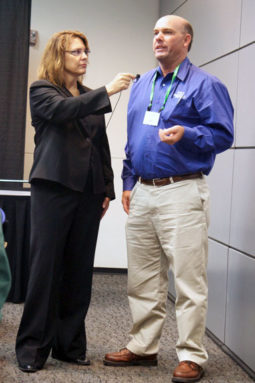A week ago at the 2011 World Dairy Expo, Dairy Management, Inc. hosted a presentation called "Leading the Conversation: Answering consumer questions about dairy." The event was led by Jane Hillstrom and Michele Ruby and provided dairy producers with the opportunity to practice responding to tough questions from consumers.
Those in attendance were also encouraged to reach out to consumers through their social media networks and to join themyDairy program.Producers were provided with a small booklet of key messages to share with consumers as well as some tips for responding to difficult questions.
Listed here are those techniques provided by DMI.
• Be a strong listener.
In a situation where there are conflicting opinions, it's easy to ignore what the other person is saying. By immediately defending your position, you send the signal that you've stopped listening.
Next time, try listening before responding — no matter how many hairs may be standing up on the back of your neck! Listening bridges the gap between you and the speaker.
• Ask questions.
By asking to learn more from the speaker, you demonstrate an interest in their thoughts and show you are trying to understand the basics of their assumptions or attitudes.
Use phrases such as, "Help me understand how you came to form your opinion. Have you ever had this experience before? Did someone else tell you this information?" By listening and asking questions, you gain knowledge that helps in addressing your opponent's concerns and advancing your position. At the same time, you should courtesy, reinforce confidence and gain respect.
• Make sure you heard what they said.
Repeat what you heard in your own words. For example, "I think what you're asking is, 'Do you care about animals?'" You should see or hear an affirmation or clarification, then proceed with your answer.
Especially when diverse opinions are offered, it is easy to completely miss the point being made. Repeating or restating their concern in your own words lets the speaker know you're listening.
• Find common ground.
Starting a sentence with, "I know we can both agree that we have a passion for caring for animals" diffuses the situation and leads to finding a logical conclusion. Focusing solely on your differences never advances the situation.
Finding common ground may not change an opinion, but it is the first step to being heard. It can also lead to more dialogue and, eventually, problem-solving.
• State your principles.
One way to connect is to state your beliefs or principles. Your principles tell a story. If someone is questioning your commitment or practices, ask, "May I share with you my beliefs?" When they say "yes," continue stating your case: "I believe that caring for animals is my top priority."
• Break the rhythm.
It's important to break the rhythm of an adversarial questioner when you realize they are asking increasingly volatile questions. You can do this by beginning your response with "Let's step back and look at the bigger picture." This diffuses a threatening style and takes the emotional edge off a heated exchange.
• Bring up the subject of concern.
By being proactive, you can control the tone and exhibit transparency regarding the topic. The fact that you brought it up prior to the questioner diffuses the subject matter. Transparency increases trust. PD
Do you have experiences responding to difficult questions from consumers? Tell us about in the comments section below.

-
Emily Caldwell
- East Coast Editor
- Email Emily Caldwell



